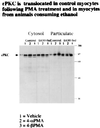Activation of epsilon protein kinase C correlates with a cardioprotective effect of regular ethanol consumption
- PMID: 9653175
- PMCID: PMC20964
- DOI: 10.1073/pnas.95.14.8262
Activation of epsilon protein kinase C correlates with a cardioprotective effect of regular ethanol consumption
Erratum in
- Proc Natl Acad Sci U S A 1999 Mar 16;96(6):3330
Abstract
In addition to decreasing the incidence of myocardial infarction, recent epidemiological data suggest that regular alcohol consumption improves survival after myocardial infarction. We recently found that chronic ethanol exposure induces long-term protection against cardiac ischemia-reperfusion injury, which improves myocardial recovery after infarction. Furthermore, this cardioprotection by ethanol is mediated through myocyte adenosine A1 receptors. We now determine the role of protein kinase C (PKC) in ethanol's protective effect against ischemia-reperfusion injury. Using perfused hearts of ethanol-fed guinea pigs, we find that improved contractile recovery and creatine kinase release after ischemia-reperfusion are abolished by PKC inhibition with chelerythrine. Western blot analysis and immunofluorescence localization demonstrate that regular ethanol consumption causes sustained translocation (activation) of epsilonPKC, but not delta or alphaPKC. This same isozyme is directly implicated in ischemic preconditioning's protection against ischemia-reperfusion injury. Our findings suggest (i) that regular ethanol consumption induces long-term cardioprotection through sustained translocation of epsilonPKC and (ii) that PKC activity is necessary at the time of ischemia to mediate ethanol's protective effect against ischemia-reperfusion injury. Studying this selective effect of ethanol on epsilonPKC activation may lead to new therapies to protect against ischemia-reperfusion injury in the heart and other organ systems.
Figures






References
-
- Klatsky A L, Armstrong M A, Friedman G D. Am J Cardiol. 1990;66:1237–1242. - PubMed
-
- Rimm E B, Giovannucci E L, Willett W C, Colditz G A, Ascherio A, Rosner B, Stampfer M J. Lancet. 1991;338:464–468. - PubMed
-
- Fuchs C S, Stampfer M J, Colditz G A, Giovannucci E L, Manson J E, Kawachi I, Hunter D J, Hankinson S E, Hennekens C H, Rosner B, Speizer F E, Willett W C. N Engl J Med. 1995;332:1245–1250. - PubMed
-
- Stampfer M J, Colditz G A, Willett W C, Speizer F E, Hennekens C H. N Engl J Med. 1988;319:267–273. - PubMed
-
- Gaziano J M, Buring J E, Breslow J L, Goldhaber S Z, Rosner B, VanDenburgh M, Willett W, Hennekens C H. N Engl J Med. 1993;329:1829–1834. - PubMed
Publication types
MeSH terms
Substances
Grants and funding
LinkOut - more resources
Full Text Sources
Other Literature Sources

